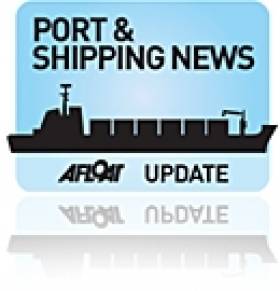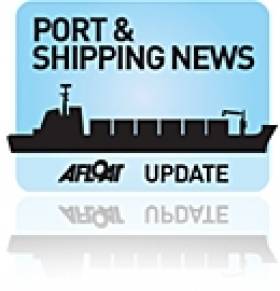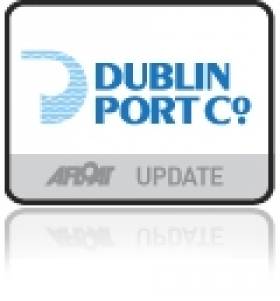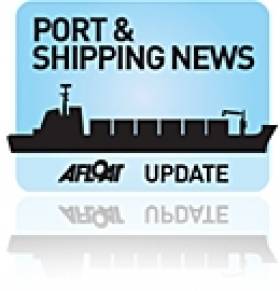Displaying items by tag: Burke Shipping Group
Arklow’s Final ‘Green’ Newbuild Makes A Splash!
#ArklowsLastestLaunch – Arklow Breeze had the honour of been launched as the newest and final newbuild of six cargoships from a Dutch yard last Friday, writes Jehan Ashmore.
The ceremony for Yard No. (Nb) 414 saw a successfull sideways launch at the Westerbroek yard of Ferus Smit. The same Dutch yard having completed all of the previous bulk oriented general cargoships of 8,660dwt for Arklow Shipping. She joins the company's Dutch division based in Rotterdam, Arklow Shipping Netherland N.V.
A 119m long hull form without a bulb-less bow design has given the series 'green' credentials. This is to improve operating efficiency by reducing wave resistance in varying sea-state conditions without compromising on cargo-loads.
The bulb-less concept, instead features a straight-stemmed bow to allow a slender hull entry to slice into the waves. While at the same time taking into account various loading drafts. Total performance of this bow design will also be better than that of a bulb optimised for one single-draft and flat water only conditions.
Almost a year ago, Arklow Bay was also given a spectacular launch, see VIDEO. As for Arklow Breeze she is due to enter service next month.
She follows Arklow Brave which called to Dublin Port this month and whose agents are the Burke Shipping Group which invested in new port infrastructure late last year.
The new cargoship had loaded scrap metal elsewhere in the port alongside the Hammond Lane Metal Company. She departed laden with the cargo bound for Leixoes in Portugal.
The sisters will be mainly employed in the shipment of wheat, corn and other bulk commodities in European waters.
Greenore Port Acquired by Burke Shipping Group
#GreenorePort - Burke Shipping Group, the principal operating subsidiary of the Doyle Group, has The Irish Times writes acquired Greenore Port in Co Louth.
Previously the port was jointly owned by One51 and the state-owned Dublin Port Company. The price Burke Shipping paid for the port is not known but it is thought to be in the region of €5 million. Burke did not respond to requests for comment.
The company, which employs 300 people and has offices in all major Irish ports, is understood to plan to invest a substantial sum in improving Greenore. It will be the first significant port to be entirely privately owned in the Republic.
Burke Shipping plans to target the container and bulk shipping market and compete with the Dublin Port Company and other ports for this business.
Greenore is strategically located next to the Dublin-Belfast economic corridor, so it is capable of servicing both cities. For more on the acquisition by the group click HERE.
The group as previously reported were a potential bidder back in August.
More recently an investment in port infrastructure at their Dublin Port container terminal has further consolidated the company's business in the lo-lo sector.
Burke Shipping Group Invest in New RTG for Dublin Port Container Terminal
#NewGantryCrane – A new rubber tyre gantry crane (RGT) for Burke Shipping Group's container terminal in Dublin Port is currently been assembled and is due to be operational in a fortnight, writes Jehan Ashmore.
The investment by BSG in the quayside infrastructure is to facilitate growing demand and increase capacity at the container terminal located in Alexandra Basin.
The RTG was manufactured by Killarney based Liebherr Container Cranes. This brings to 7 the total of RTG's in operation coupled with 12 cranes representing a €30 million investment by BSG.
In addition to the group operates container terminals in Belfast, Cork and Foynes.
Burke Shipping Group Bids for Greenore Port
#GreenorePort – The Irish Times reports that the Burke Shipping Group, has emerged as a bidder in the final stages of the race for Greenore port in Co Louth.
It is one of three remaining bidders for the port, which as previously reported is jointly owned by the investment company One51 and the State-owned Dublin Port Company.
Warrenpoint Harbour, which recently announced its pre-tax profit doubled to £850,000 (€1.07 million) in 2013, is also among the final bidders for the port. The third bidder is believed to be a family-owned company with interests in transport.
Greenore is strategically located next to the Dublin-Belfast economic corridor, so it is capable of servicing both cities, meaning its new owner will be watched out for closely by Irish exporters.
For much more on this story click HERE.
New €1.5m Rail-Spur for Dublin Port
The minister welcomed "the important investment by Dublin Port Company in its rail network. It will further enhance the attractiveness of the port as a destination for rail-based freight. The project represents a commitment on the part of Dublin Port Company and Iarnród Éireann to customers who want to move goods by rail".
The project took six months to complete and the public private partnership involved Dublin Port Company, Iarnród Éireann and the first customer of the new facility, International Warehousing and Transport (IWT).
IWT is a privately owned Irish logistics company, which already operates freight-trains to Ballina that are expected to increase from 4 to 5 trains per week in each direction as a result of this investment. The rail-operator believes that the service will save up to 5.5million road kilometres annually and reduce CO2 emissions by up to 2,750 tonnes.
The Irish Exporters Association also welcomed the development of the IWT freight operation at the new facility, where increased frequency in services will enhance Ireland's contribution to the European Union's modal shift aspirations from road to rail.
The Common User Terminal is also open to other shipping companies. Existing clients using the lo-lo container terminal operated by Burke Shipping Group through its subsidiary Portroe Stevedores are C2C Lines, APL, Coastal Containers, Evergreen, Gracechurch and OOCL . The terminal also has a ro-ro berth facility where CLdN /Cobelfret operate from on routes to Belgium and The Netherlands.
In addition to the Dublin-Ballina service the port exports 400,000 tonnes of lead and zinc concentrate from the freight customers Boliden/Tara Mines with 15 trains per week. The facility at Alexandra Basin Jetty is regularly served by vessels from Arklow Shipping Ltd, where the 2011 newbuild Arklow Field (2,998 tonnes) is currently berthed.
- Dublin Port
- Dublin Port Company
- Arklow Shipping Ltd
- Irish Exporters Association
- Port of Dublin
- Ports and Shipping News
- IEA
- Minister for Transport
- Ocean Pier
- Irish Rail
- Iarnrod Eireann
- Portroe Stevedores
- Dublin Port news
- IWT
- ASL
- Leo Varadkar T.D.
- Port of Dublin news
- Railfreight
- International Warehousing and Transport
- Alexandra Basin East
- Common User Terminal
- Burke Shipping Group
- Clnd Cobelfret
- Boliden
- Tara Mines
- Arklow Field
- Dublin Shipping
- Lead mines
- Zinc mines
- Irish Railways
- Dublin Port railhead




























































